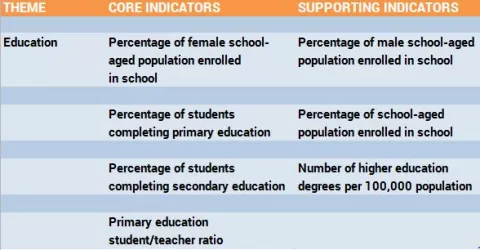
By George Karayannis, LEED AP
We continue our series on the new ISO 37120 Smart City standard with a look at the second of 17 themes defined in the standard – education indicators. As previously described, ISO 37120 includes 46 ‘Core’ (must report) and 54 ‘Supporting’ (should report) indicators.
The ISO standard clearly states that the smart city indicator classification has “no hierarchical significance and is organized alphabetically.” That said, it is easy to view the education theme as perhaps the most important of the 17 indicators in that education is essential to human development. Education powers scientific advancement and economic development, enables people to provide for themselves and their families, and allows for individual enrichment and personal growth.
U.S. President John F. Kennedy said, “Let us think of education as the means of developing our greatest abilities, because in each of us there is a private hope and dream which, fulfilled, can be translated into benefit for everyone and greater strength for our nation.”
Let's explore the indicators designed to help cities measure progress on education.
This table is excerpted from ISO 37120:2014, Annex A on page 64, with the permission of ANSI on behalf of ISO. (c) ISO 2014 - All rights reserved
Core Indicators
1. Percentage of female school-aged population enrolled in school.
This indicator reflects the relative importance of educating young women in male-dominated societies, and the fact that women make up nearly two thirds (almost 500 million) of the world’s illiterate adults. As the African teacher and missionary James Emman Kwegyir Aggrey said, “The surest way to keep people down is to educate the men and neglect the women. If you educate a man you simply educate an individual, but if you educate a woman, you educate a family.”
2. Percentage of students completing primary education: survival rate.
By measuring the survival rate of primary education, the ISO is helping cities report on the “internal efficacy of an education system.” Primary education is commonly believed to provide the foundation for sustainable literacy, which helps people overcome poverty and disease. This indicator measures the percentage of students who have reached each successive primary education grade without failing or moving, and includes both public and private schools.
3. Percentage of students completing secondary education: survival rate.
This indicator is measured similarly to the primary education rate indicator. Secondary education is compulsory in most countries as it essential for creating a labor pool with the cognitive skills to become the teachers, nurses and health workers on which society depends. Furthermore, secondary education is increasingly important for both producers and consumers in today’s technology-centric economy.
4. Primary education student/teacher ratio.
This indicator measures the availability of teachers in a city and can reflect the strength and quality of a school system. According to UNESCO, the average student/teacher ratio for developed countries is 13.6. Crowded classrooms are more common in Southern Asia and Sub-Saharan Africa, where 22 of the 27 countries have 40 or more pupils per teacher.
Supporting Indicators
1. Percentage of male school-aged population enrolled in school.
This indicator includes both primary and secondary levels, as well as both public and private institutions.
2. Percentage of school-aged population enrolled in school.
This indicator focuses on the overall educational opportunity in a city and measures the penetration of formal education among all school-aged children.
3. Number of higher education degrees per 100,000 population.
This indicator is included because higher education is a major contributor to a city’s economic development and quality of life, and is generally regarded as a key enabler of social mobility. The Organization for Economic Co-operation and Development’s 2011 study reports an estimated 53.5% of Russian adults held a tertiary degree, which was the highest proportion among developed countries. The U.S. ranked fifth overall at 42%, led by the Washington D.C. metro area at 46.8%, according to the Brookings Institute.
My research for this series has reinforced the real value of ISO 37120 – namely, the development of global accepted and fully transparent definitions for key smart city indicators. There are many ‘best city’ rankings already available across a broad range of criteria. However, despite the academic rigor implemented and the best intentions of the study’s sponsors it is difficult if not impossible for cities to use these anecdotal studies for benchmarking their city services and quality of life over time. That is why a standard methodology is needed, and why ISO 37120 is expected to have a profound impact on the measurement and definition of smart city attributes worldwide.
###
George Karayannis has over 25 years of emerging technology and complex solutions sales, business development and marketing experience and has held leadership positions at Schneider Electric, Lockheed Martin Energy Solution, AT&T and wireless sensor startups. He has also served as a city councilman and is restoring a 100-year old opera house to LEED Gold status. @gkarayannis
So far in our series:



